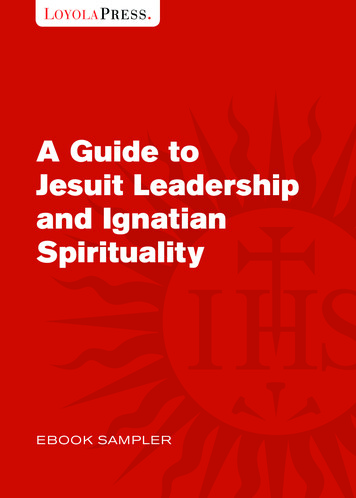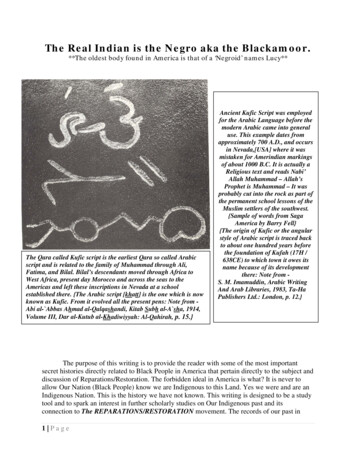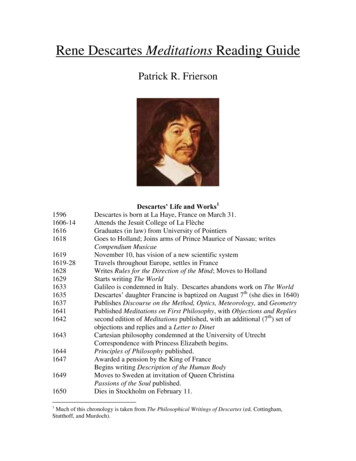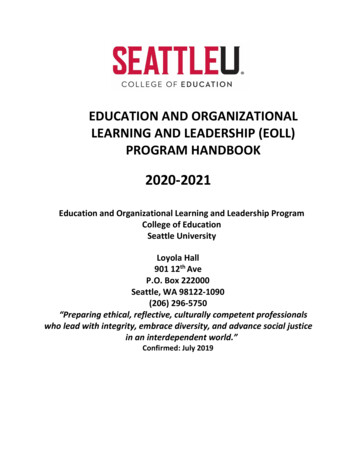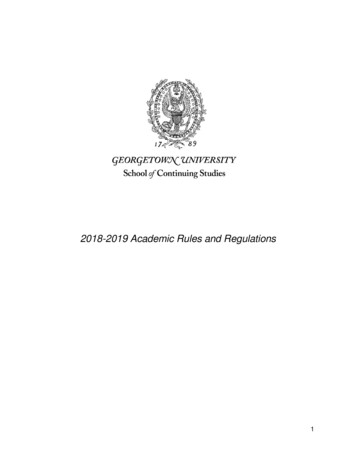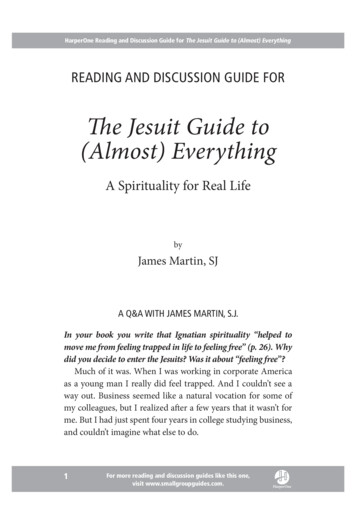
Transcription
HarperOne Reading and Discussion Guide for The Jesuit Guide to (Almost) Everythingreading and discussion Guide forThe Jesuit Guide to(Almost) EverythingA Spirituality for Real LifebyJames Martin, SJA Q&A with James Martin, S.J.In your book you write that Ignatian spirituality “helped tomove me from feeling trapped in life to feeling free” (p. 26). Whydid you decide to enter the Jesuits? Was it about “feeling free”?Much of it was. When I was working in corporate Americaas a young man I really did feel trapped. And I couldn’t see away out. Business seemed like a natural vocation for some ofmy colleagues, but I realized after a few years that it wasn’t forme. But I had just spent four years in college studying business,and couldn’t imagine what else to do.1For more reading and discussion guides like this one,visit www.smallgroupguides.com.
HarperOne Reading and Discussion Guide for The Jesuit Guide to (Almost) EverythingWhen I stumbled upon the idea of entering a religious order Iknew very little about the Jesuits. During the application processI read about St. Ignatius Loyola, but it wasn’t until entering theJesuit novitiate that I really began to understand the spiritualityof Ignatius. From the first moment I heard about “finding God inall things,” it just seemed to fit me. It was a practical, sensible,and user-friendly spirituality. Also, I have an active imaginationso praying imaginatively—once I got over my initial worriesabout making things up in my head—felt natural, too.The most important thing about Ignatian spirituality wasthat it helped me enter into a deeper relationship with God.That was the real beginning of feeling free, because that was thetime that God began to change and form me.What inspired you to write The Jesuit Guide to (Almost) Everything?There are probably hundreds, if not thousands, of bookswritten about Ignatius, his writing, and his spirituality. Butmost are written for predominantly Catholic audiences andpublished by Catholic publishing houses. I felt that what mightbe helpful would be a completely mainstream approach, gearedtoward people who had zero background in anything to dowith Ignatius. That’s not to say that this book can’t be used by people who are intimately familiar with Ignatian spirituality.But I wanted to write something that would not presume anything. That’s why the opening line of the book—Who is St.Ignatius Loyola, and why should you care?—was such animportant one for me. I wanted to make the book as userfriendly as possible, essentially writing it for a person who waslike me at age twenty-seven: someone who knew nothing aboutthe way of Ignatius at all.2For more reading and discussion guides like this one,visit www.smallgroupguides.com.
HarperOne Reading and Discussion Guide for The Jesuit Guide to (Almost) EverythingHave you been surprised by the strong response The JesuitGuide has received? Have you encountered any non-Catholicor non-Chris tian readers who’ve found universal truths inIgnatian spirituality?I’ve been very surprised! Of course I know that Ignatianspirituality is accessible, but I’m so close to it that I sometimesforget what a hidden treasure it is. Many readers have told me,for example, that the examen has changed the way they relateto God. Just as many have said that the book has freed them touse their imagination in prayer. So some of the things I maytake for granted about Ignatian spirituality come as a revelationto so many p eople, which is very gratifying.At the same time I’ve been delighted by the response amongJesuits. It’s not that they’re not always encouraging—rather, myconcern was that I might offer an interpretation of Ignatius thatsome other Jesuits might not agree with. But the response frommy brother Jesuits has been astonishingly supportive. Manyhave told me that they’re happy that the book is helping tobring Ignatian spirituality into the mainstream, and that thebook includes so many Jesuit wisdom figures of our time. Somehave even said, much to my surprise, that my take on Ignatianspirituality has helped deepen their own understanding of it,which is the highest praise of all.As for non-Catholic or non-Chris tian readers, yes, manyhave written to say that they have found tenets of Jesuit spirituality, particularly the emphasis on freedom and detachment,useful in their own lives. Also, using the imagination in prayeris of great use to someone from any religious tradition. Finally,many seekers have said that they appreciate Ignatius’s welcomeof people on different paths to God. Few things would makeIgnatius happier, I would think.3For more reading and discussion guides like this one,visit www.smallgroupguides.com.
HarperOne Reading and Discussion Guide for The Jesuit Guide to (Almost) EverythingIs there anything you wish that you could have included in thebook, anything that you couldn’t fit in because of space?Yes, two things. First, I wish I had spent more time on theconcept of agere contra. So I’ll do it here. The term means “toact against.” Ignatius often advises that when you find yourselfconfronting an “unfreedom” you should act in the oppositemanner so as to free yourself. For example, when I was in thenovitiate, I told the novice director that last ministry I wantedto do was hospital work, because I was afraid of the sights andsmells. So he talked to me about agere contra, and of course,assigned me to work a hospital! This helped me to move pastsome of my unfreedoms in that area. But the key here is discernment. You have to ask yourself: Is this simply something Ido not desire for good and healthy reasons? Or is it an unfreedom, and should I use some agere contra to, in a sense, movepast it?Second, I wish I had more space to speak about a few moreof my Jesuit heroes, whose lives embody Ignatian spirituality.Originally, I had a whole section on three Jesuit saints: St.Aloysius Gonzaga, St. Jean de Brébeuf, and St. AlbertoHurtado, which had to be set aside for space purposes. Maybementioning them here will encourage people to read aboutthem on their own.What would you ask Ignatius if you could ask him anything?I’d ask him the first question a retreat director ever asked me:“Who is God for you?” I’ll bet his answer would be amazing.4For more reading and discussion guides like this one,visit www.smallgroupguides.com.
HarperOne Reading and Discussion Guide for The Jesuit Guide to (Almost) EverythingQuestions ForPersonal Reflection orReading GroupsChapter One:A Way of Proceeding Consider the four elements of Ignatian spirituality(pp. 5–11): finding God in all things, becoming a contemplative in action, looking at the world in an incarnational way, and seeking freedom and detachment. Doesany approach come more naturally to you than others?Do you shy away from any—and if so, what might be theroot of that resistance? What other spiritualities—Chris tian or otherwise—areyou familiar with? How does the practicality of the way ofIgnatius offer a “bridge to God” in a new or different way? What’s the most compelling part of the life of St. Igna-tius? Where might your life intersect with his? For example, have you ever found God in times of vulnerability?Chapter Two:The Six Paths Which of the six paths to God are you on now, andwhich have you found yourself on in the past? Have you5For more reading and discussion guides like this one,visit www.smallgroupguides.com.
HarperOne Reading and Discussion Guide for The Jesuit Guide to (Almost) Everythingever experienced the “envy” the author describes in thefirst path? Fr. Martin speaks frankly about both the negative andthe positive aspects of organized religion, arguing thatthe positives—like love, forgiveness, charity, comfort,community, and the moral imperative to challenge thestatus quo (p. 45)—stack up higher than the negatives.Have you ever questioned the worth of organized religion? What helped you rediscover its value? Fr. Martin warns against spirituality separated from “thewisdom of a community” (p. 50). Consider times in yourlife when you’ve nurtured your spiritual life within acommunity, and times when your spirituality may havebeen a more solitary pursuit. How did your relationshipto God change, or the spiritual insights you found differ?What does the community add? What does it makemore difficult? Have you ever had profound emotions that surprisedyou? Did you experience those feelings as communication from God? Why or why not?Chapter Three:What Do You Want? Why do you think desire has a “disreputable reputation”in some religious circles? When have you experiencedthe “deep longings of our hearts” that the authordescribes? How have you accomplished the sometimesdifficult task of finding these holy desires among the surface wants that are often so distracting?6For more reading and discussion guides like this one,visit www.smallgroupguides.com.
HarperOne Reading and Discussion Guide for The Jesuit Guide to (Almost) Everything Fr. Martin refers several times throughout the book to“the God of Surprises,” that is, the God who meets us inways we often don’t or wouldn’t predict. Have you everexperienced the God of Surprises? One of Fr. Martin’s first lessons when he entered theJesuit novitiate was that “God meets you where you are”(p. 81). Was that insight new to you? How might Godmeet you where you are now?Chapter Four:Beautiful Yesterdays In Chapter Four, Fr. Martin introduces the examen anddiscusses its flexibility. How can you avoid the pitfall ofmoving through the examen like a checklist? The author’s experience of praying about Wanda (p. 93)led him to see God’s presence in her. What p eople inyour life might be unexpected carriers of God’s grace foryou? Fr. Martin says that it’s often easier to see God in retro-spect (p. 97). Does that ring true? Looking back overyour life, can you see God in places you might have overlooked at the time?Chapter Five:Beginning to Pray Do you ever feel guilty about asking God for help? Doesthe author’s advice that petitionary prayer is “natural,7For more reading and discussion guides like this one,visit www.smallgroupguides.com.
HarperOne Reading and Discussion Guide for The Jesuit Guide to (Almost) Everythinghuman, and common” (p. 105) help you feel more comfortable with that form of prayer? One revelation that Fr. Martin gained from his firstretreat (pp. 105–10) is that God wanted to be in relationwith him, or, as Ignatius said, that the “Creator dealsdirectly with the creature.” Do you believe this in yourown life? Which of the traditional definitions of prayer (“raising ofone’s mind and heart to God,” “God’s self-communication,” a “long, loving look at the real,” and “conversationwith God”) on pp. 113–114 resonate with you?Chapter Six:Friendship with God The author highlights these words from Psalm 139, “OLord, you have searched me and known me” (p. 122).Does it help you, or frighten you, to think about Godknowing you so intimately? How do you respond to theidea of a “friendship with God?” Fr. Martin notes that the more common ways of hearingGod in prayer is listening carefully to emotions, insights,memories, feelings, physical feelings, desires, and incommunicable experiences. Which of these have you experienced in prayer? How do you try to listen to God in yourprayer? In this era of cell phones, laptops, and endless gadgetry,we are, as Fr. Martin writes, “gradually losing the art ofsilence” (p. 141). How can you create silence in your life?8For more reading and discussion guides like this one,visit www.smallgroupguides.com.
HarperOne Reading and Discussion Guide for The Jesuit Guide to (Almost) EverythingDo you tend to enjoy or dread quiet “unplugged” time?What might be the source of any feelings of apprehension?Chapter Seven:God Meets You Where You Are Consider the forms of prayer discussed in ChapterSeven: contemplation, lectio divina, centering prayer, thecolloquy, communal prayer, rote prayer, journaling,nature prayer, music, and work. Did any of these formsof prayer surprise you? Have you tried any newapproaches to prayer since reading this book? Fr. Martin’s original objection to Ignatian contemplationwas that it was just “making things up in your head”(p. 146). In response, David, his spiritual director, suggested that God could work through his imagination.Does that make sense? Try selecting a favorite passage from your sacred Scrip-tures and using it for “Ignatian contemplation.” Whatwas your experience like?Chapter Eight:The Simple Life Why do you think poverty, chastity, and obedience are“threatening” in our culture? Fr. Martin’s experience in East Africa showed him that“less stood between the refugees and God,” and therefore9For more reading and discussion guides like this one,visit www.smallgroupguides.com.
HarperOne Reading and Discussion Guide for The Jesuit Guide to (Almost) Everythingthey were close to God. What stands between you andGod? Is there any way you can minimize that distance? Does a “sensible simplicity” sound appealing or uncom-fortable? How might living more simply draw you closerto God? What, to you, is the underlying message of PedroArrupe’s surprising experience in the slum, onpp. 211–212?Chapter Nine:Like the Angels? The author addresses the old stereotype of the cold andbitter priest or nun (p. 217). Can you think of examplesto the contrary? Do you know friends or family members—widows or widowers, unmarried men or women—who are single and celibate? How do they love? “Chastity is about love,” Fr. Martin says, and suggeststhat even p eople in committed relationships can learnabout “freedom” in love. How can this freedom help youlove more deeply and honestly? Consider Fr. Martin’s suggestions under “How Can ILove Chastely?” (p. 227). Which ones do you feel thatyou are already living? Which ones might you like to putinto action?10For more reading and discussion guides like this one,visit www.smallgroupguides.com.
HarperOne Reading and Discussion Guide for The Jesuit Guide to (Almost) EverythingChapter Ten:More by Deeds Than by Words The Jesuit way of life emphasizes an underappreciatedpart of the spiritual life: friendship. How have yourfriends been blessings in your life, and how have theymoved you closer to God? Ignatius’s “Presupposition” (pp. 234–236) means giving eople the benefit of the doubt. When have you foundpthat approach rewarding? “One of the best gifts to give a friend is freedom,” writesFr. Martin (p. 243). What does that mean for you?Where might you be called to give your friends morefreedom? Consider “Some Barriers to Healthy Friendship”(pp. 246–248) and “Healthy Friendships” (pp. 259–263).Have these re commendations shed light on any of yourrelationships?Chapter Eleven:Surrendering to the Future In his provincial’s decision to delay his theology studies,Fr. Martin met with disappointment. Yet his spiritualdirector suggested that God might be “forming” himthrough this difficult time (p. 278). What painful experiences have formed you? How do you understand Walter Ciszek’s insight that God’swill is found in the “reality of the situation” (p. 281)?11For more reading and discussion guides like this one,visit www.smallgroupguides.com.
HarperOne Reading and Discussion Guide for The Jesuit Guide to (Almost) Everything Sister Janice suggested that an important part of life islearning to “surrender to the future that God has in storefor you”—even when that includes suffering (p. 284). Inwhat areas of your life have you had to “surrender”?Where did that surrender lead? The Ignatian approach to suffering includes an imagina-tive encounter with the Jesus who has suffered. Do youbelieve that God is “with you” as you go through difficulttimes? How have you experienced this?Chapter Twelve:What Should I Do? One of the main goals of the way of Ignatius is “indiffer-ence,” which is often confused with simply not caringabout things. How could a greater sense of healthy indifference help you? Ignatian discernment starts with the belief that God iswith you in making decisions and that acting in concertwith God’s desires for you sometimes brings “consolation.” Have you ever felt a feeling of “rightness” or “consolation” after making a good decision? Fr. Martin notes that the “Third Time” of decision mak-ing, when things seem very unclear, is probably the mostcommon. Which of the decision-making steps he outlines on pp. 319–326 sound the most helpful? Fr. Martin speaks about making decisions as your “bestself.” Who is your “best self ” and how would that personact in ways different from the way you are living now?12For more reading and discussion guides like this one,visit www.smallgroupguides.com.
HarperOne Reading and Discussion Guide for The Jesuit Guide to (Almost) EverythingChapter Thirteen:Be Who You Is! Have you ever imagined yourself as having a “vocation”?How would you describe it? Or, what desires do youhave that could help you discover your vocation? The author’s list of challenges for developing a spiritual-ity of work are: finding time for God and you, findingGod around you, finding time for solitude, working andliving ethically, and remembering the poor. In whichareas could you grow? Karl Rahner’s reflection on “The Dignity of Work,” in thebox on p. 374, praises work that is hidden from publicrecognition. Who in your life does such hidden work?What kind of hidden work do you do? Read Fr. Martin’s suggestions on pp. 385–386 for“Becoming Yourself.” Which insight was new to you?Which might help you the most?Chapter Fourteen:The Contemplative in Action Now that you’ve read the book, how would you describe,in your own words, the Ignatian ideal of being a “contemplative in action”? Fr. Martin uses the Jesuit saying “The road is our home”to underline the fact that we are always en route to God.How might the image of the journey help you in thespiritual life?13For more reading and discussion guides like this one,visit www.smallgroupguides.com.
HarperOne Reading and Discussion Guide for The Jesuit Guide to (Almost) Everything The “Take, Lord, Receive” prayer (pp. 396–397) is, as Fr.Martin says, a “tall order.” What would it mean for youto “give yourself ” to God? What’s your favorite part of Ignatian spirituality?14For more reading and discussion guides like this one,visit www.smallgroupguides.com.
HarperOne Reading and Discussion Guide for The Jesuit Guide to (Almost) EverythingTen Things You (Almost) Didn’tKnow About Jesuits1. They invented the trap door. Without the Jesuits, whowrote and directed plays in their sixteenth and seventeenth-century schools, modern theater would be vastlydifferent and—to take one example—the Wicked Witchof the West wouldn’t have been able to disappear so easily in “The Wizard of Oz.” Jesuits also invented or perfected the “scrim,” the sheer curtain used in theaterstoday.2. They discovered quinine (called “Jesuit bark” in the sev-enteenth century), which is still used for anti-malarialdrugs and, not incidentally, for tonic water. Without theJesuits you wouldn’t be enjoying your gin and tonic.(Nor would the West have known as early about ginsengor the camellia flower.)3. Their dictionaries and lexicons of the native languages inNorth America in the seventeenth century were the firstresources Europeans used to understand these ancienttongues, and today they still provide scholars with someof the earliest transcriptions of these languages. Of theletters and reports that Jesuit explorers sent back toEurope, the American historian Francis Parkman said,“In respect to the value of their contents, they areexceedingly unequal.”15For more reading and discussion guides like this one,visit www.smallgroupguides.com.
HarperOne Reading and Discussion Guide for The Jesuit Guide to (Almost) Everything4. They located the source of the Blue Nile, and chartedlarge stretches of both the Amazon and the Mississippirivers.5. They educated in their high schools, colleges and univer-sities Descartes, Voltaire, Molière, Arthur Conan Doyle,James Joyce, Fidel Castro and Alfred Hitchcock—not tomention Bing Crosby, Bill Clinton and Denzel Washington.6. They founded the city of São Paulo, Brazil. Specifically,Blessed José de Anchieta (1534–1597) did so, with somehelp of course, during his missionary work there.7. They championed the Baroque style of architecture byfostering it in their churches across Europe in the earlyseventeenth century. The mother church of the Jesuits,the Church of the Most Holy Name of Jesus, often called“Il Gesù,” features what many historians term the firstfully Baroque facade. Across town, the Jesuit brotherAndrea Pozzo designed the trompe-l’oeil ceiling in theChurch of St. Ignatius that fools people to this day.8. There are thirty-five craters on the moon named forJesuit scientists. And Athanasius Kircher, a seventeenthcentury Jesuit scientist, called “master of a hundred arts”and “the last man to know everything,” was a geologist, abiologist, a linguist, a decipherer of hieroglyphics, andthe inventor of the megaphone.9. They inspired the 1954 film On the Waterfront, based onthe groundbreaking labor-relations work of the JesuitJohn Corridan (1911–1984), the “Waterfront Priest” whoworked on the docks with labor unions in New York City16For more reading and discussion guides like this one,visit www.smallgroupguides.com.
HarperOne Reading and Discussion Guide for The Jesuit Guide to (Almost) Everythingin the 1940s and 1950s. His part was played by Karl Malden. The films “The Mission” and “Black Robe” were alsoinspired by real-life Jesuits.10. They count fifty saints and dozens of blesseds and vener-ables (near-saints), including the theologian and cardinalSt. Robert Bellarmine; the English writer and martyr St.Edmund Campion; and the North America martyrs St.Isaac Jogues and his companions. Among their famous“former” members are Garry Wills, John McLaughlin,and Jerry Brown.17For more reading and discussion guides like this one,visit www.smallgroupguides.com.
HarperOne Reading and Discussion Guide for The Jesuit Guide to (Almost) EverythingFriends in the LordJesuit Lives Are Always InterconnectedSt. Ignatius Loyola (1491–1556). The founder of the Society ofJesus was a former hothead, courtier, soldier, and ladies’ manwho was wounded by a cannonball in a battle. During his longrecuperation, the Spaniard started to wonder if he could be likesome of the great saints, and turned his life around. To cheerup downcast Jesuits, he often did Basque dances to encouragethem to smile. One of Ignatius’s best friends was. . .St. Francis Xavier (1506–52). The church’s greatest missionarysince St. Paul, he traveled to lands that few Westerners had seen(or imagined), and wrote letters back home showing a greatlove for the new peoples he visited, rare for a missionary of thetime. Francis would do anything to draw people into conversation, even ringing a bell to get their attention. His adventurouslife was an inspiration for the quiet. . .St. Aloysius Gonzaga (1568–91). As a young man Aloysiusgave up an immense fortune (as well as his rights as a marquis)in order to join the Jesuits, even after his father, the Marquis ofCastiglione, threatened to have him whipped. When he enteredthe novitiate, he carried with him a letter from his father to thenovice director. It read: “I simply say I am sending you themost precious thing I possess.” Aloysius died at twenty-twoafter caring for victims of the plague in Rome. His gentle disposition mirrored that of. . .18For more reading and discussion guides like this one,visit www.smallgroupguides.com.
HarperOne Reading and Discussion Guide for The Jesuit Guide to (Almost) EverythingSt. Alphonsus Rodriguez (1532–1617). The humble Jesuitbrother led a sad early life, losing his wife and children to illness. After joining the Jesuits, Alphonsus was assigned to workas “porter,” or doorkeeper, at the Jesuit school in Majorca,Spain. Trying to treat each person as if he or she were Jesushimself, Alphonsus would answer each knock on the door withthe words, “I’m coming Lord!” While at Majorca Alphonsusbecame close friends with. . .St. Peter Claver (1580–1654). Peter was sent from his nativeSpain to work with the slaves in Cartagena, in what is nowColombia, where he tirelessly ministered to the slaves, awaitingthem with baskets of food as their ships pulled into the docksafter their horrific voyages. For his work Peter was called elesclavos de los esclavos: the slave of the slaves. Working in theNew World around the same time was. . .St. Jean de Brébeuf (1593–1649). One of the great missionaries to “New France,” Jean, a French Jesuit, earned a reputationfor hardiness among the Native American people because ofhis physical prowess. He was called “Echon,” or “he who carriesgreat loads,” by the Hurons. Jean’s determination to understandthe peoples with whom he ministered drove him to becomefluent in the Huron language and compile that tongue’s firstwritten dictionary. His martyrdom at the hands of the Hurons’enemy, the Iroquois, inspired another worker in what wouldbecome North America, named. . .Pierre-Jean de Smet (1801–73). Born in Belgium, De Smetworked in the American West and was said to have traveled180,000 miles in his peripatetic lifetime. His primary work was19For more reading and discussion guides like this one,visit www.smallgroupguides.com.
HarperOne Reading and Discussion Guide for The Jesuit Guide to (Almost) Everythingamong the Flatheads, Crees, Chippewas, and Blackfeet. DeSmet (after whom a town in South Dakota is named) wasknown as “Friend of Sitting Bull” for his work with the Siouxleader. De Smet’s incredibly active life mirrors that of. . .St. Alberto Hurtado (1901–52). One of the newest Jesuitsaints, and only the second Chilean saint, Alberto was a multitasker: a lawyer, priest, writer, and social worker, who started aCatholic magazine, worked with the poor and founded “ElHogar de Cristo,” (the Hearth of Christ) for poor youth in hiscountry. The beat-up green pickup truck Alberto used to visitthe poor in the city is still maintained in the shrine dedicatedto him in Santiago. He was as devoted to the working man aswas. . .John Corridan (1911–84). A “labor priest” who worked withdockworkers in New York in the 1940s and 1950s, he foughtcorruption and organized crime, and began “labor schools” inNew York City to teach the principles of social justice. FatherCorridan was the inspiration for the movie “On the Waterfront.” Karl Malden’s famous speech as “Father Barry” in thehold of a ship is inspired by one of Fr. Corridan’s actual homilies. Corridan faced injustice head on, as did another AmericanJesuit named. . .Walter Ciszek (1904–84). In 1963, President John F. Kennedyworked out a behind-the-scenes deal that finally released thisJesuit priest, who had spent nearly twenty years in Moscow’snotorious Lubianka prison and in Soviet labor camps in Siberia. The American Jesuits had already sent out a notice years20For more reading and discussion guides like this one,visit www.smallgroupguides.com.
HarperOne Reading and Discussion Guide for The Jesuit Guide to (Almost) Everythingbefore announcing his death, and were astonished when hereturned home. Ciszek, who is currently being considered forcanonization, moved into a house near Fordham University, inNew York, where another gifted Jesuit would soon take up ateaching assignment there. He was named. . . .Avery Cardinal Dulles (1918–2008). Son of the U.S. Secretaryof State John Foster Dulles, and a decorated war hero, he converted to Catholicism while an undergraduate at Harvard. As aJesuit priest, he authored dozens of books and hundreds ofarticles, and was considered the dean of American Catholictheologians during his lifetime. He was also the first AmericanJesuit named a cardinal. Cardinal Dulles was a contemporary ofanother well-known American Jesuit. . .Daniel Berrigan (born 1921). The priest, writer, poet, andpeace activist was a Jesuit whose protests against the VietnamWar landed him for a time on the FBI’s “Ten Most WantedFugitives” list. Berrigan, who continued his activism into his80s, was a member of the “Catonsville Nine,” who burned draftdocuments, and the “Plowshares Eight,” who began an antinuclear weapons movement. Like the rest of these Jesuits, Berrigan reminds us that. . .Being yourself comes in many flavors, and, as the saying goes,“If you’ve met one Jesuit, you’ve met one Jesuit!”21For more reading and discussion guides like this one,visit www.smallgroupguides.com.
bring Ignatian spirituality into the mainstream, and that the book includes so many Jesuit wisdom figures of our time. Some have even said, much to my surprise, that my take on Ignatian spirituality has helped deepen their own understanding of it, which is the highest praise of all

